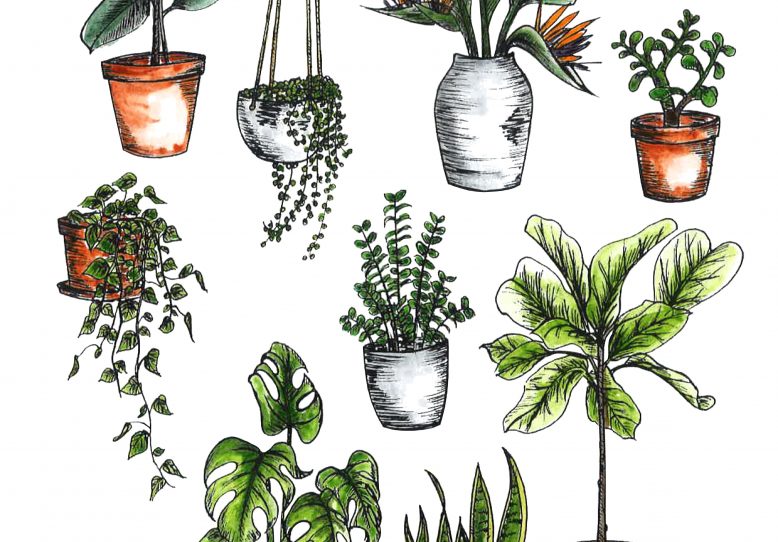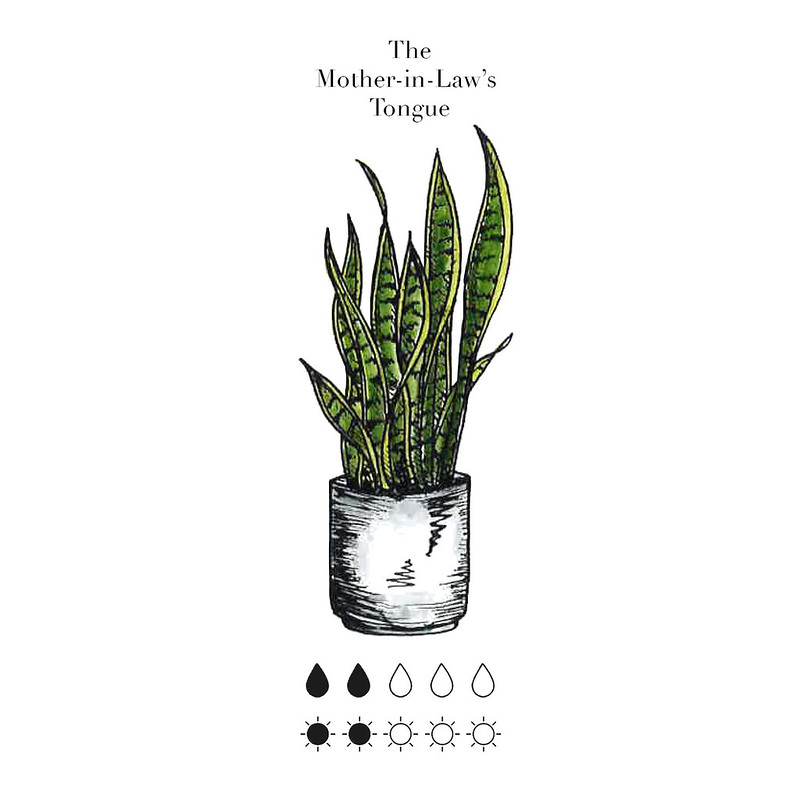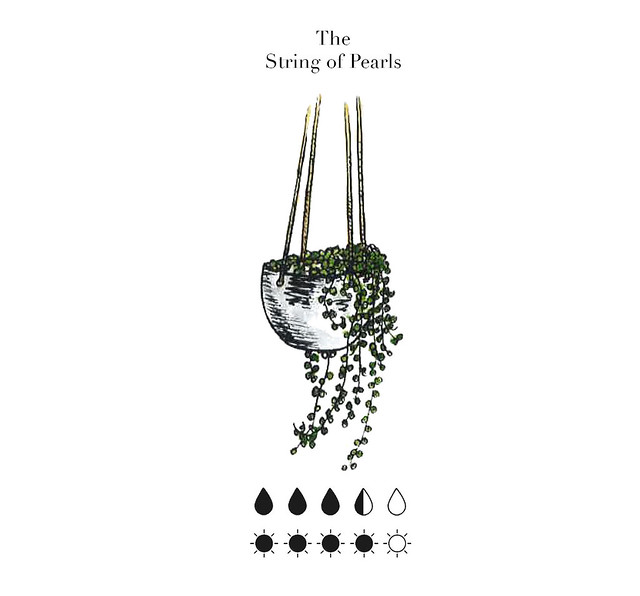Ok so it won’t be news to you that I’m a HUGE indoor plant enthusiast.
This has come on strong in the last few years, namely when we started decorating the new studio – an industrial space that desperately needed plants to give it some life and oxygen (and also give your eyes some relief). I spent more money than I would like to admit on the plants for the studio, and in the last two years here I’ve subsequently learnt a lot about what works and what doesn’t when it comes to keeping them alive. Fast forward and now that we’re doing the apartment up I’ve been once again stocking up on the greenies, but this time with enough experience to know what to buy and where to put them.
Knowing how much you guys love plants too, we decided to put together a plant guide, something for you to take with you to the nursery if you’re inspired to add a little green to your studio home or dorm. We consulted our local nursery and our own experience for the tips and Annie did these gorgeous illustrations of all my favourite indoor plants. We’ve given you a general overview and also a plant by plant reference guide too. Enjoy! Oh and stay tuned in the next few days for our second post, which will further help you decide what plants you should buy for your indoor space. xxx
How To Care For Indoor Plants
Luckily you don’t have to have the greenest of thumbs to keep plants around the house, but before you do go and buy a forest worth of them from your local nursery, it’s worth considering the time and energy you are able to put into caring for your plants. Depending on the species, some will require a little more TLC while others are known to be virtually un-killable. Here are some general tips to keep in mind.
Direct or indirect sunlight
All plants need sunlight to photosynthesise, but the type of sunlight needed by each plant may differ. Some plants like the direct sun rays hitting their leaves while others like reflected sunlight. It may be a case of trial and error to find out if your plant is receiving the right amount of light. Most houseplants are tropical plants that flourish in indirect sunlight, but refer below for specific . You will be able to tell if your plant is exposed to too much light if the leaves are dull and have brown edges or spots.
Watering and soil moisture
The way you water your indoor plants largely determines its longevity as watering wrong is the main cause of death. In general, some plants like their roots constantly moist (but not wet), while others actually prefer the top inch or so of their soil to dry out between waterings. A good indicator of when your plant needs watering is to touch the surface of the soil or just under it to see if it is moist or dry. Providing sufficient drainage also prevents plants from drowning or developing root rot from sitting in wet soil. Knowing if your plants are receiving the right amount of water will come down to observation, practice and experimentation because each plant will react differently depending on their location and size. You will also notice that in warmer months, you will need to water more frequently than in the colder months. Refer to the plant by plant guide below for more details about watering.
Cleaning
It is important to clean indoor plants often to rid them of dust and insects, and to prevent disease. Dust and grime isn’t just an aesthetic issue, it actually blocks the pores on the plant’s leaves and impairs their ability to breath. For smaller plants use a clean, damp cloth to wipe the leaves and for larger plants give it a hose down in the sink or shower.
We’ve put together a quick comparison of the plants that we’ve found to be the best and easiest to look after, and a couple of tips on how best to care for them. Hopefully this will help you take care of the ones you already own or to pick out new ones to splash around your apartment, studio or office.
Sunlight
Loves bright shaded light.
Water
If you let its surface soil dry between waterings you won’t need to water your rubber plant more than once a week and even less in winter (once or twice a month). If the leaves are turning yellow, wilting and dropping off then you are giving the plant too much water, however, if the leaves are simply drooping then you can up its water intake. Another easy way tell if you have watered it too much is if after 30 minutes there is still water remaining in the tray – throw this water out.
Good to know
The rubber plant is one of the easiest plants to grow. If you do notice a bit of grime, wipe and clean the large, glossy green leaves with a damp sponge to remove dust and dirt build up. The rubber plant doesn’t like to be moved around as changes to temperature and light may cause it to drop its leaves so it’s best to leave it when you’ve found it in a nice spot in your house.
Sunlight
The bird of paradise is a tropical plant so it requires plenty of direct sunlight. You will know if your bird of paradise is not getting enough sun if the leaves remain green but start curling in.
Water
The bird of paradise requires regular watering once or twice a week to keep the soil slightly moist, but be careful of over watering. Bird of paradise have an active and dormant period. During the warmer, active months, keep the soil moist, while in the cooler, dormant months let the soil dry out between waterings.
Good to know
It loves to be misted so spray the plant once or twice a week to maintain humidity.
Sunlight
Cacti require abundant sunlight so placing them in a bright sunny window is ideal, just make sure you don’t let the sun shine directly on it as it might burn.
Water
Cacti are extremely well adapted to living indoors and only require modest amounts of water. In fact the fastest way to kill a cactus is to over water it! A good test of whether it’s time to give your plant a drink is to insert a wooden stick or pencil into the soil, if soil sticks to it when you take it out, don’t water your plant just yet. If the stick or pencil comes out clean, water your cacti well allowing any excess water to drain off.
Good to know
Like the bird of paradise, cacti have an active period during the warmer months and a dormant period during the cooler months. During winter, you can get away with giving your cacti a sip of water once a month. If you notice some shrivelling during winter as well, this is perfectly normal as the cacti is “resting”.
Sunlight
Fiddles like bright, indirect sunlight so keeping them within a foot of a large window is ideal.
Water
You will need to water your fiddle once a week, a half a litre is good for the larger 1.5-2m varieties and a little less for the shorter varieties. Allow the soil to dry between waterings. Fiddles also love humidity which isn’t so good when the air gets dry in winter. Spray your fiddle once a week to keep the leaves humid, you can do this at the same time you do the watering.
Good to know
A good sign of a healthy fiddle is when the leaves are a vibrant green, but interestingly out of all the plants we’ve had in the studio this has been the the one that has flourished the least.
Sunlight
It loves moderate to low light conditions, even artificial office lights.
Water
The pathos flourishes with sporadic waterings making it very easy to grow. Similar to the mother in law’s tongue though, don’t allow the soil to become swampy as the pathos is susceptible to root rot. Check to see that the top two inches of soil have dried out before watering. Each plant is different but if you notice your pathos is wilted, yellow or spotted and does not have much new growth, you will need to review your watering habits.
Good to know
The golden pathos can grow in soil or in vases of water, its trailing vines reaching up to 2.5m, and we’ve found them to be virtually unkillable!
Sunlight
Jade plants thrive best in bright sunlight. However if you have been keeping the plant in lower lighting conditions move it into brighter sunlight gradually as sudden changes can burn the leaves.
Water
Check see if the top soil is dry to touch before watering which will usually be around once a week. During warmer months, keep the soil slightly moist while in winter you can get away with watering once every couple of weeks, letting it dry out a bit more. If you see your jade plant shedding leaves or has brown spots, it is a sign the plant needs more water.
Good to know
Jade plants are a tough succulent, requiring very easy care. They are known to get top heavy, so to prevent them from tipping over, slip its planter pot into a larger pot and fill in the gaps with soil. This steadies the base and saves you from having to repot.
Sunlight
Also known as the snake plant, the mother in law’s tongue is a great indoor plant for beginners because it flourishes in any lighting condition from bright indirect sunlight to shade.
Water
It can go for up to a month without water so make sure to keep the soil relatively dry – it is better to under water than over water. I water my snake plant a quarter cup of water every few weeks, making sure the soil dries between each watering. If you see its leaves drooping and becoming slimy, it means that the soil is too wet, remove any affected leaves and adjust your watering frequency.
Good to know
Occasionally it may be necessary to prune the leaves as the point of the leaf can be very sharp, simply clip off the points whenever they appear.
Sunlight
Also known as the Monstera or Swiss Cheese plant, the philodendron thrives in bright to moderate but never direct sunlight. Keeping it within 1-2 metres of a window is best. Plants kept in lower light tend to produce smaller leaves with none of the iconic holes or splits.
Water
It is drought friendly, preferring to be on the dry side so the philodendron can be watered every 7 to 10 days. Keep the soil evenly moist and drain well. You can adjust your watering as needed – if you notice the leaves are turning yellow you are over watering and the leaf edges are brown, you are under watering.
Good to know
When the philodendron is young, its leaves are glossy and heart shaped. They develop their signature holes and cut outs as they mature.
Sunlight
The string of pearls, with its trailing foliage that resembles a beaded necklace is a sturdy succulent that thrives in bright light with occasional direct sunlight.
Water
It is drought tolerant and capable of surviving long periods without water, in fact watering your string of pearls too often increases its chances of root rot. Provided you allow the top soil to dry out between waterings, you will find that the watering schedule will fluctuate from once a week to once every two weeks or so. In winter, the watering frequency decreases to about once a month (yay!).
Good to know
Occasionally, you may need to prune back any dead stems and pearls to keep your plant looking neat and tidy.
Sunlight
Handles low lighting well so should be kept away from any direct sunlight.
Water
The Zanzibar is a tough plant when it comes to watering and likes to be kept on the dry side, you can even let the soil become dusty. It is best to water the plant thoroughly bi-monthly, just make sure you don’t allow it to sit in water afterwards because this will cause root rot and the leaves will turn yellow.
Good to know
Also known as the ZZ plant, it is an indoor plant that is considered almost impossible to kill, it is a slow grower and it’s hardiness is due to the waxy leaves which help hold water in.
Illustrations by Annie Huang. Thank you Annie they are gorgeous!
Like this guide? Pin it for later!






























